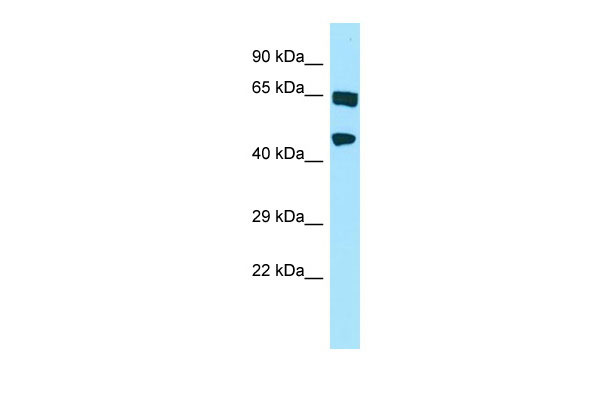HABP4 Antibody - N-terminal region
Rabbit Polyclonal Antibody
- SPECIFICATION
- CITATIONS
- PROTOCOLS
- BACKGROUND

Application
| WB |
|---|---|
| Primary Accession | Q5JVS0 |
| Other Accession | NM_014282, NP_055097 |
| Reactivity | Human, Mouse, Rat, Bovine |
| Predicted | Human, Mouse, Rat, Bovine |
| Host | Rabbit |
| Clonality | Polyclonal |
| Calculated MW | 46kDa |
| Gene ID | 22927 |
|---|---|
| Alias Symbol | IHABP4, Ki-1/57, MGC825, SERBP1L |
| Other Names | Intracellular hyaluronan-binding protein 4, IHABP-4, IHABP4, Ki-1/57 intracellular antigen, HABP4 (HGNC:17062) |
| Format | Liquid. Purified antibody supplied in 1x PBS buffer with 0.09% (w/v) sodium azide and 2% sucrose. |
| Reconstitution & Storage | Add 50 ul of distilled water. Final anti-HABP4 antibody concentration is 1 mg/ml in PBS buffer with 2% sucrose. For longer periods of storage, store at 20°C. Avoid repeat freeze-thaw cycles. |
| Precautions | HABP4 Antibody - N-terminal region is for research use only and not for use in diagnostic or therapeutic procedures. |
| Name | HABP4 (HGNC:17062) |
|---|---|
| Function | Ribosome-binding protein that promotes ribosome hibernation, a process during which ribosomes are stabilized in an inactive state and preserved from proteasomal degradation (By similarity). Acts via its association with EEF2/eEF2 factor at the A-site of the ribosome, promoting ribosome stabilization in an inactive state compatible with storage (By similarity). Plays a key role in ribosome hibernation in the mature oocyte by promoting ribosome stabilization (By similarity). Ribosomes, which are produced in large quantities during oogenesis, are stored and translationally repressed in the oocyte and early embryo (By similarity). Also binds RNA, regulating transcription and pre-mRNA splicing (PubMed:14699138, PubMed:16455055, PubMed:19523114, PubMed:21771594). Binds (via C-terminus) to poly(U) RNA (PubMed:19523114). Seems to play a role in PML-nuclear bodies formation (PubMed:28695742). Negatively regulates DNA-binding activity of the transcription factor MEF2C in myocardial cells in response to mechanical stress (By similarity). |
| Cellular Location | Nucleus. Cytoplasm. Cytoplasm, Stress granule. Cytoplasm, sarcoplasm {ECO:0000250|UniProtKB:A1L1K8}. Nucleus, nuclear body. Nucleus, nucleolus. Nucleus speckle. Nucleus, Cajal body. Nucleus, gem. Note=Transported into the nuclear compartment in activated leukocytes (PubMed:9523163). Inhibition of methylation alters its distribution between the nuclear and cytoplasmic compartments (PubMed:16879614, PubMed:19523114). Methylation may be required for its localization in subnuclear structures, such as nucleoli, nuclear speckles, Cajal bodies and Gemini of coiled bodies (gems) (PubMed:19523114). Colocalizes with FMR1, FXR1 and FXR2 in cytoplasmic stress granules (PubMed:21771594). In myocardial cells, localization at the sarcoplasm is reduced in response to mechanical stress (By similarity). {ECO:0000250|UniProtKB:A1L1K8, ECO:0000269|PubMed:16879614, ECO:0000269|PubMed:19523114, ECO:0000269|PubMed:21771594, ECO:0000269|PubMed:9523163} |
| Tissue Location | Highly expressed in brain, heart, and kidney, and moderately expressed in skeletal muscle. Also expressed in a variety of tumor cell lines and in activated but not resting leukocytes |

Thousands of laboratories across the world have published research that depended on the performance of antibodies from Abcepta to advance their research. Check out links to articles that cite our products in major peer-reviewed journals, organized by research category.
info@abcepta.com, and receive a free "I Love Antibodies" mug.
Provided below are standard protocols that you may find useful for product applications.
References
Huang L.,et al.J. Biol. Chem. 275:29829-29839(2000).
Humphray S.J.,et al.Nature 429:369-374(2004).
Kobarg J.,et al.Exp. Clin. Immunogenet. 14:273-280(1997).
Lemos T.A.,et al.FEBS Lett. 533:14-20(2003).
Nery F.C.,et al.J. Biol. Chem. 279:11444-11455(2004).
If you have used an Abcepta product and would like to share how it has performed, please click on the "Submit Review" button and provide the requested information. Our staff will examine and post your review and contact you if needed.
If you have any additional inquiries please email technical services at tech@abcepta.com.













 Foundational characteristics of cancer include proliferation, angiogenesis, migration, evasion of apoptosis, and cellular immortality. Find key markers for these cellular processes and antibodies to detect them.
Foundational characteristics of cancer include proliferation, angiogenesis, migration, evasion of apoptosis, and cellular immortality. Find key markers for these cellular processes and antibodies to detect them. The SUMOplot™ Analysis Program predicts and scores sumoylation sites in your protein. SUMOylation is a post-translational modification involved in various cellular processes, such as nuclear-cytosolic transport, transcriptional regulation, apoptosis, protein stability, response to stress, and progression through the cell cycle.
The SUMOplot™ Analysis Program predicts and scores sumoylation sites in your protein. SUMOylation is a post-translational modification involved in various cellular processes, such as nuclear-cytosolic transport, transcriptional regulation, apoptosis, protein stability, response to stress, and progression through the cell cycle. The Autophagy Receptor Motif Plotter predicts and scores autophagy receptor binding sites in your protein. Identifying proteins connected to this pathway is critical to understanding the role of autophagy in physiological as well as pathological processes such as development, differentiation, neurodegenerative diseases, stress, infection, and cancer.
The Autophagy Receptor Motif Plotter predicts and scores autophagy receptor binding sites in your protein. Identifying proteins connected to this pathway is critical to understanding the role of autophagy in physiological as well as pathological processes such as development, differentiation, neurodegenerative diseases, stress, infection, and cancer.


